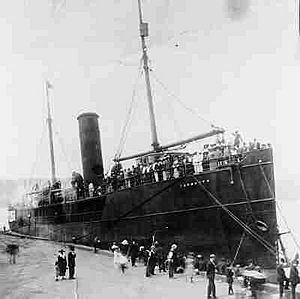Black Star Line facts for kids
 |
|
| Partnership | |
| Industry | Shipping, transportation |
| Fate | Bankruptcy |
| Founded | 1919 |
| Defunct | 1922 |
|
Area served
|
Transatlantic |
The Black Star Line was a shipping company started in 1919 by Marcus Garvey and other members of the Universal Negro Improvement Association (UNIA). Its main goal was to help transport goods and African Americans across the world, especially to connect with Africa.
The company got its name from the successful White Star Line, which Garvey hoped to copy. The Black Star Line was a big part of Garvey's plan to encourage people of African descent to return to Africa, known as the Back-to-Africa movement. However, the company faced many challenges and was mostly unsuccessful. Despite its short life, the Black Star Line remains an important symbol for followers of Garvey and for Pan-Africanism, which is the idea of a united global African community. It is different from the Black Star Line, which is the national shipping company of Ghana.
Contents
History of the Black Star Line
The Black Star Line was officially started on June 27, 1919. It aimed to raise $500,000 by selling shares for five dollars each at UNIA meetings. This allowed many people to invest in the company.
The first leaders of the Black Star Line included Marcus Garvey, Edgar M. Grey, Richard E. Warner, George Tobias, Jeremiah Certain, Henrietta Vinton Davis, and Janie Jenkins. Marcus Garvey was the President. Six months later, the company decided to try and raise even more money, aiming for $10 million.
First Ships and Challenges
The Black Star Line surprised many people when it bought its first ship, the SS Yarmouth, just three months after starting. The plan was to rename it the SS Frederick Douglass. The Yarmouth had been a coal ship during World War I and was not in good shape when purchased. After repairs, the Yarmouth sailed for three years between the U.S. and the West Indies. It was the first Black Star Line ship to have an all-black crew and a black captain.
The Yarmouth was not the only ship bought in poor condition. Garvey spent more money on other ships that also had problems. One ship, the SS Shady Side, once took people on short trips on the Hudson River. However, it later sank because of a leak. Another ship, the steam yacht Kanawha, had once been owned by a wealthy businessman. After being renamed the SS Antonio Maceo by the Black Star Line, it had a serious accident with its engine.
Company Difficulties
Besides buying ships that were not in good condition, the Black Star Line faced other problems. There were issues with how the company was managed. Also, some people working for the government's Bureau of Investigation (which later became the FBI) tried to cause problems for the company. For example, some agents reportedly damaged the ship's engines.
On its first trip, the Yarmouth carried a shipment of whiskey from the U.S. to Cuba. It arrived quickly, but the company lost money because it didn't have a place to dock in Havana, and there was a strike by workers. On another trip, a cargo of coconuts spoiled because Garvey wanted the ships to make special stops at important ports for ceremonies.
Legal Problems and End of the Company
In 1919, Marcus Garvey and other Black Star Line leaders faced legal challenges. They were accused of using the mail to promote the company with a picture of a ship they didn't yet own. The picture showed a ship called the Orion, which was renamed the Phyllis Wheatley in the company's brochure. The Black Star Line was trying to buy this ship but didn't own it at the time.
In 1922, Garvey and three other officials were charged by the U.S. government. Garvey admitted that a large amount of money had been lost. Only Garvey was found guilty, and he was sentenced to five years in prison. In 1927, President Calvin Coolidge sent Garvey back to Jamaica.
The Black Star Line stopped operating in February 1922. The company lost a lot of money, estimated to be between $630,000 and $1.25 million.

Black Star Line in Culture
The Black Star Line has been remembered in many songs and cultural works, especially in reggae music.
- Reggae singer Fred Locks had a famous song in 1976 called "Black Star Liners." It described Garvey as a prophet and spoke of the ships returning.
- The band Culture included a song called "Black Starliner Must Come" on their 1977 album, Two Sevens Clash.
- Other reggae artists like The Regulars and Black Slate also recorded songs about the Black Star Line.
- Blues singers such as Hazel Meyers and Rosa Henderson also sang about the company.
- The rap group Brand Nubian mentioned the Black Star Line on their 1993 album In God We Trust.
- The British electronic group Black Star Liner was named after the company.
- The rap duo Black Star, formed by Mos Def and Talib Kweli, also took their name from the Black Star Line.
Legacy and Symbolism
The idea of the Black Star Line continues to be a powerful symbol. The flag of Ghana, for example, includes a black star as a tribute to its own national shipping company, which was also called The Black Star Line. This shows how Garvey's vision, even though his company faced difficulties, inspired future generations and nations.



